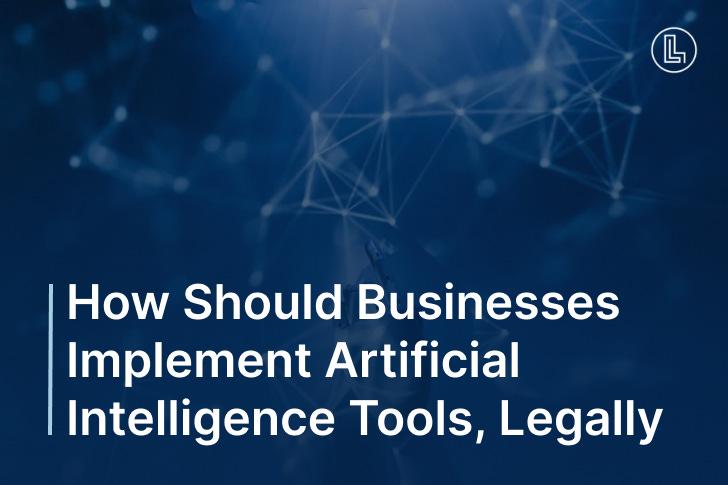How Should Businesses Implement Artificial Intelligence Tools, Legally
Authors: Louis Lehot and Natasha Allen
Business leaders, from CEOs to CIOs to project managers, are rapidly adopting generative artificial intelligence (AI) tools to transform their organizations, harnessing the technology to drive efficiency, streamline processes, and enhance operational capability.
A KPMG survey revealed that nearly 65% of U.S. executives “believe generative AI will have a high or extremely high impact on their organization in the next three to five years, far above every other emerging technology.” However, many admit they currently lack the necessary technology, talent, and governance to implement AI effectively. For example, many companies do not have a formal AI internal usage policy. These leaders are now investing considerable effort into understanding AI and strategizing its integration.
How are Corporate Leaders Leveraging AI Technologies Effectively?
Beyond automating repetitive tasks like customer service chatbots and robotic process automation (RPA) for administrative tasks, AI enhances critical decision-making by providing deeper insights into data. This includes predicting market trends, analyzing consumer behavior, and optimizing supply chains and resource management.
Furthermore, AI drives innovation and accelerates product development, particularly in sectors such as pharmaceuticals, high-tech, and automotive manufacturing. AI can expedite the R&D process, refine product design, and reduce time-to-market. These industries benefit from AI precision and efficiency resulting in an increased competitive edge.
AI can personalize the customer experience and aid marketers by analyzing large data sets to uncover customer behavior patterns. AI models can also assist with forecasting sales trends and market demand, enabling more effective resources and personalized customer interactions.
Practical Considerations for AI Implementation
Corporate leaders should be thoughtful when implementing AI, with end principles in mind. For example, we recommend the implementation of traceability applications to ensure that corporate users are adhering to AI-specific provisions in contracts and that employees are adhering to AI policies. When reviewing third-party vendor contracts, some vendors have revised their contacts to adopt AI language and governance without even mentioning AI-specific terms. A common usage of generative AI is to generate source code for common algorithms based on open-source libraries. Corporate leaders should ensure that employees are not using these databases to create critical IP that will lack authorship or IP rights.
What are Some of the Legal Issues Leadership Should Understand?
AI regulations are evolving and vary globally. States like California are developing AI legislation, and the EU has already enacted regulations. The United States lacks comprehensive legislation at the federal level, while state legislation is proliferating with varied outcomes. One legal area that has been much discussed is the issue of bias and discrimination, especially in the context of tools used by corporate HR departments. Many of the new laws being proposed, including one that just passed the Colorado legislature, have specific new requirements to deter potential bias and discrimination.
Different industries, such as health care organizations, higher education, and financial institutions are also subject to specific regulations that apply to the use of AI. With all this uncertainty and the patchwork of varied legislation, corporate leadership must do an in-depth analysis of where their business is situated, whether they are in a specifically regulated industry, and how to set up AI governance policies that make sense. Use your legal counsel to stay informed of pending legislation and how potential changes may have implications for your current and future business.
Corporate leaders also need to be aware of the changing legal landscape for privacy and security and the intersection with AI tools. For example, the data used in AI applications must be collected, used, and stored in compliance with all privacy regulations, such as GDPR and CCPA.
And, of course, there is the issue of intellectual property (IP) and ownership of the content that generative AI creates. Due to the ownership of the data inputs into generative AI engines, there are questions surrounding who owns the IP of the AI-generated outputs that have yet to be firmly decided, and company leaders would be advised to proceed with caution as they utilize the technology to produce content or even inventions. On a related note, the question of who is liable when an AI system causes harm or even fails is also in flux.
How can Corporate Leadership Move Forward With Implementation of AI Solutions?
Company leadership should collaborate closely with legal counsel to address these issues from the outset and create policies, plans, and procedures that comply with all applicable laws and regulations and mitigate risk. This also means staying on top of regulatory developments and updating policies as new laws come on board. Corporate leadership should also implement traceability solutions to ensure that employees adhere to these policies.
Employees should undergo meaningful training to understand the legal and ethical concerns surrounding AI, and regular audits should be conducted to identify any concerns over non-compliance, with a focus on deterring bias and discrimination. There is also a growing call for AI systems to be more transparent, with all stakeholders having a clear understanding of how the tools are making decisions. When companies implement more explainable AI technologies from the start, it can help to address this concern.
As with the implementation of any new technology in organizations, the benefits of AI come with risks, both known and unknown. The legal and regulatory landscape is evolving on a country-by-country, state-by-state basis. Every organization will need to assess whether and when to implement generative AI tools. Ultimately, organizations that fail to adopt new technologies will fail to compete on a quality and cost basis with their competitors, while those that implement it carelessly can experience detrimental effects. While we firmly believe the rewards will outweigh the risks, the assessment must be done, and the potential liabilities must be identified and ultimately mitigated. Working with experts, including legal counsel, developing a roadmap to implementation, adopting governance policies, and training your base of users and employees will all accelerate the quality and speed of adoption.
Originally published at https://foleyignite.com.
Discover more about Louis Lehot and explore additional professional insights on his website: https://louislehot.com.
Explore Related Content:





